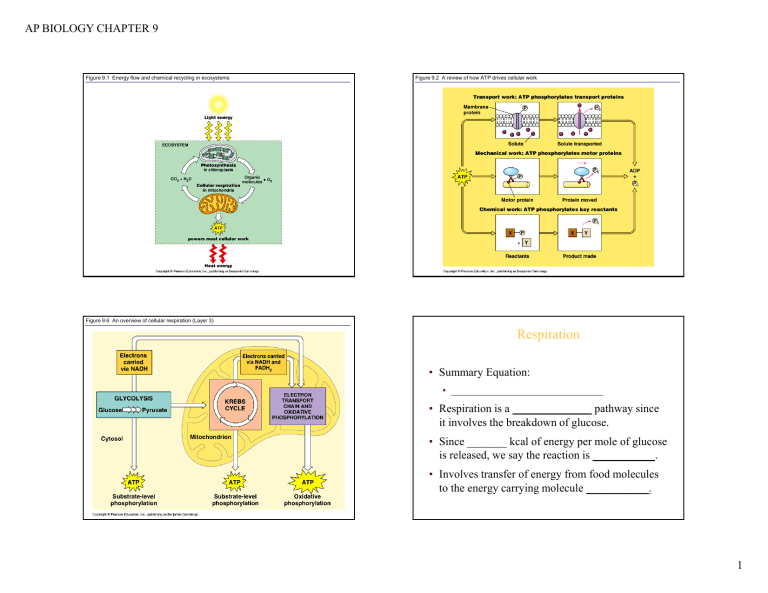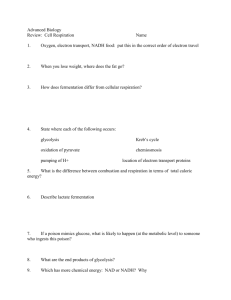Respiration

AP BIOLOGY CHAPTER 9
Figure 9.1 Energy flow and chemical recycling in ecosystems Figure 9.2 A review of how ATP drives cellular work
Figure 9.6 An overview of cellular respiration (Layer 3)
Respiration
• Summary Equation:
• _______________________________
• Respiration is a ______________ pathway since it involves the breakdown of glucose.
• Since _______ kcal of energy per mole of glucose is released, we say the reaction is ___________.
• Involves transfer of energy from food molecules to the energy carrying molecule ___________.
1
AP BIOLOGY CHAPTER 9
Respiration
• Involves redox reactions, which release energy when electrons are gained (_____________) or lost (___________)
• The coenzyme _____________ carries electrons in the electron transport chain.
Steps
• __________________
• Occurs in __________________
• Glucose oxidized into two _________ molecules (3C)
• _________________________________
• Occurs in the ________________________________
• Breaks pyruvate derivative (acetyl coA) into ______
• ___________________________
• Located at _____________________________
• Electrons procees from coenzymes to _____________
Figure 9.9 A closer look at glycolysis: energy investment phase (Layer 2)
Glycolysis
• In: __________________________
• Out: ____________________________
• Occurs over a series of steps. Energy investment phase requires expenditure of ATP. The loan is repaid with interest in the ______________ stage.
• Net, ___ ATP and ____NADH are produced.
• Glycolysis occurs whether or not __________ is present, and it occurs in the cytosol.
• Products may proceed to either Krebs cycle
(aerobic) or _______________ (anaerobic).
2
AP BIOLOGY CHAPTER 9
Figure 9.9 A closer look at glycolysis: energy payoff phase (Layer 4)
Figure 9.10 Conversion of pyruvate to acetyl CoA, the junction between glycolysis and the Krebs cycle
Krebs Cycle
• Before the cycle can begin, pyruvate produced in glycolysis must be converted to ____________
• The Krebs cycle occurs in the _______________
________________
• For each turn of the Krebs wheel, we get __ ATP,
__ NADH, and __ FADH
2
• Since 2 pyruvates are produced in glycolysis, __ turns are needed for each glucose molecule.
Figure 9.11 A closer look at the Krebs cycle (Layer 4)
3
AP BIOLOGY CHAPTER 9
Figure 9.12 A summary of the Krebs cycle Figure 9.4 NAD + as an electron shuttle
Electron Transport Chain
• By the end of Krebs, we have only made ___ ATP directly. Most of the energy needed to make ATP is stored in the bonds of ___________________.
• Hydrogen carriers shuttle hydrogen ions to the inner membrane of the mitochondria.
• Energy is released as electrons descend a cascade, called the electron transport chain. Electrons pass between proteins in the membrane, called
_________________. The final electron acceptor is _________________.
Oxidative Phosphorylation
• Energy released by ETC pumps ________ into intermembrane space.
• Return to matrix by passing through ________
_________. Called ______________________.
• In total, the ETC produced about ____ ATP per molecule of NADH and ____ ATP per molecule of FADH2 that enters, for a total of _____ ATP by oxidative phosphorylation.
4
AP BIOLOGY CHAPTER 9
Figure 9.13 Free-energy change during electron transport Figure 9.14 ATP synthase, a molecular mill
Figure 9.15 Chemiosmosis couples the electron transport chain to ATP synthesis Figure 9.16 Review: how each molecule of glucose yields many ATP molecules during cellular respiration
5
AP BIOLOGY CHAPTER 9
Anaerobic Resporation
• In absence of oxygen, the pyruvate produced in glycolysis is converted into _________ in alcohol fermentation of lactic acid in lactic acid fermentation.
• Human muscle cells use _________ fermentation
• Similarities:
• Glucose -- > _____________
• ___________is the oxidizing agent
Figure 9.17a Fermentation
Fermentation
• Differences:
• How NADH is converted back into NAD+
• Final electron acceptor not ________________
• Amount of energy harvested: _________ ATP per glucose in aerobic respiration vs. _____ in anaerobic.
• Facultative anaerobes can survive either climate, but use Krebs and ETC is oxygen is present.
Figure 9.17b Fermentation
6
AP BIOLOGY CHAPTER 9
Figure 9.x2 Fermentation Figure 9.18 Pyruvate as a key juncture in catabolism
Figure 9.19 The catabolism of various food molecules Figure 9.20 The control of cellular respiration







